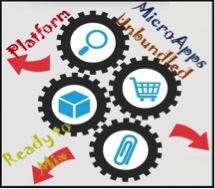11:55 AM
MicroApps: Unbundle Your Product Platform
We have already begun to see the great unbundling on Web mega-platforms such as Google, Facebook, Amazon, and LinkedIn. This shift in strategy represents a detour from building big websites and all-in-one Mobile Apps.
Users will continue to see more Web mega-platforms unbundle into narrowly created products, services, and features. This will lead to an era that I call The MicroApps Era.
 Products and Service Models will be re-invented as more narrowly focused, lightly branded, and customizable. These microapps will also be ready for other platforms to embed them into a more contextually appealing format, and they will be ready to be served on smaller/newer form-factors inspired by on-the-go mobile computing trends.
Products and Service Models will be re-invented as more narrowly focused, lightly branded, and customizable. These microapps will also be ready for other platforms to embed them into a more contextually appealing format, and they will be ready to be served on smaller/newer form-factors inspired by on-the-go mobile computing trends.
The financial services industry should look to the mega Web platforms to explore what it would take to start un-bundling product platforms and service models. By doing this, financial firms would begin to create microapps which can be easily immersed into new business ecosystems. The technology to do so already exists, but what is needed is a fresh take on these ideas within the product, marketing and operations elements of various financial services companies.
Targeting today’s technology curators
Mega Web platforms are exposing all aspects of their product and service model as Application Programming Interfaces (APIs). The end goal of this trend allows users to benefit from the API Economy.
Moving beyond the developer community, we also have a new group of API curators on the horizon. Curators are not the typical “techie” coder types. In fact, they are actually more aligned to end-users. These end users are becoming curators and are taking advantage of the features that APIs provide them.
For example, if a small business lacked IT staff and built its website on WordPress, today’s technologies allow average users more capabilities than ever before. Curators can update their sites to embed service locations by doing their own research, watching a Do-It-Yourself Video. They can ultimately add their office locations to Google maps. By using WordPress they could embed Google maps into their own websites. The benefit of these new capabilities is that users are now able to acquire “coding/curator” type skills in a self-taught manner.
Curator-style integration strategies may present as an economical alternative to API-based integration in B-2-B use cases. End users (not IT) in B-2-B scenarios will take on roles of curators who configure and mix micropp enabled capabilities from API providers, completely bypassing IT.
In financial services, the plan sponsor to provider space is a very good candidate for applying this strategy, for functions such as approvals management, exceptions management, and sending forms back and forth.
Simplify the user experience
Increasingly, we start an experience in one platform but find ourselves interacting with content and/or capability from a different platform. Sometimes this happens very subtly — perhaps even going unnoticed to the user — while many other times the experience of moving from one platform to another is very deliberate. Consumers can download an app for music or fitness tracker, which provide the option to use Facebook or GoogleID to log in, thus allowing users to log in without having to create a new ID password.
In financial services, here is an example of an “aspirational” microapp. A user has two distinct financial relationships: a primary banking relationship with a top US retail bank and a second for a managed account (IRA-rollovers, brokerage, etc.) with a different top US provider of retail managed accounts. Let’s say that each of these providers has a bill-pay feature, but the user desires to pay a bill using the primary banking relationship. Instead of the managed account provider trying to persuade user to use its bill-pay feature, what if it instead created an account-balance microapp? This microapp could show up in bill-pay (as an additional payment option) service of my primary banking’s website.
The concept for creating a bill-pay microapp is all about creating a sticky platform relationship. The benefit of this microapp to the user is that he or she could selectively see and use the account balances from either relationship and use bill-pay from both places. All the microapp reinforces the brand relationships for both providers.
The capabilities of today’s ever-evolving API technology landscape are creating opportunities for everyday users to become curators. The situation is also empowering technologists to innovate based on the consumerization of technology. All users can now collaborate to create new ways to engage customers and provide them with an intuitive user experience.




















